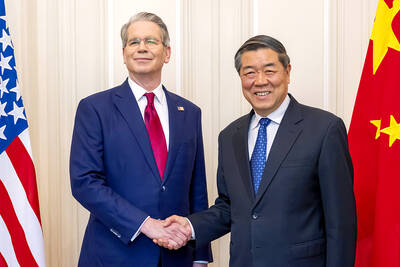Siemens said it is seeking to collaborate with local wind farm developers to build the nation’s first offshore wind turbines in 2016, a company executive said.
Siemens is working with two companies to supply wind energy solutions, Siemens Taiwan president and chief executive officer Erdal Elver told reporters last week.
In October, two wind energy companies inked agreements with the Ministry of Economic Affairs to help build offshore wind turbines with a combined annual capacity of 300 megawatts by 2020.
The ministry said it would then extend the program to increase total offshore wind power capacity to 3,000 megawatts in 2030.
The first winning bid was from Formosa Wind Power Co Ltd (海洋風力發電), an offshore wind turbine maker belonging to Swancor Industry Co Ltd (上緯企業). The second winner was a venture created by Taiwan Generations Corp (永傳能源), Century Iron and Steel Industiral Co Ltd (世紀鋼構) and CSBC Corp, Taiwan (台船).
Siemens is the world’s biggest off-shore wind turbine solution provider and has helped install farms with capacity totaling 1,600 megawatts in the UK, Germany and the US.
Siemens Taiwan, which holds the energy sector as its top revenue source for last year, said revenue grew at a faster-than-expected pace of 4 percent annually in the last fiscal year to NT$15 billion after it landed a power supply order from a local contract chipmaker.
The last fiscal year ran from Oct. 1 last year through September this year.
The company originally predicted it would only grow its revenue at the same pace as GDP this year, which is expected to expand 1.74 percent year-on-year.
Siemens said it expects to increase its revenue at the same rate as GDP next year on the back of better economic recovery in Taiwan and more construction programs, primarily new transportation systems to be launched in Taoyuan, Taipei and Greater Kaohsiung, Elver said.
However, Siemens is targeting revenue growth at double GDP growth next year, he said.
Taiwan’ GDP is expected to grow by 2.59 percent annually based on a forecast from the Directorate-General of Budget, Accounting and Statistics.
“Taiwan is still in a transition period. Certain industries are still in difficult times,” Elver said. “We believe next year will be a better year for certain industries such as the machine tool industry.”
The energy and industrial sectors would be the main driving forces next year, Elver said.
Electronic automation systems, and microcontrollers used in machine tools and motors are among industrial products provided by Siemens.

Jensen Huang (黃仁勳), founder and CEO of US-based artificial intelligence chip designer Nvidia Corp and Taiwan Semiconductor Manufacturing Co (TSMC, 台積電) on Friday celebrated the first Nvidia Blackwell wafer produced on US soil. Huang visited TSMC’s advanced wafer fab in the US state of Arizona and joined the Taiwanese chipmaker’s executives to witness the efforts to “build the infrastructure that powers the world’s AI factories, right here in America,” Nvidia said in a statement. At the event, Huang joined Y.L. Wang (王英郎), vice president of operations at TSMC, in signing their names on the Blackwell wafer to

France cannot afford to ignore the third credit-rating reduction in less than a year, French Minister of Finance Roland Lescure said. “Three agencies have downgraded us and we can’t ignore this cloud,” he told Franceinfo on Saturday, speaking just hours after S&P lowered his country’s credit rating to “A+” from “AA-” in an unscheduled move. “Fundamentally, it’s an additional cloud to a weather forecast that was already pretty gray. It’s a call for lucidity and responsibility,” he said, adding that this is “a call to be serious.” The credit assessor’s move means France has lost its double-A rating at two of the

AI BOOST: Although Taiwan’s reliance on Chinese rare earth elements is limited, it could face indirect impacts from supply issues and price volatility, an economist said DBS Bank Ltd (星展銀行) has sharply raised its forecast for Taiwan’s economic growth this year to 5.6 percent, citing stronger-than-expected exports and investment linked to artificial intelligence (AI), as it said that the current momentum could peak soon. The acceleration of the global AI race has fueled a surge in Taiwan’s AI-related capital spending and exports of information and communications technology (ICT) products, which have been key drivers of growth this year. “We have revised our GDP forecast for Taiwan upward to 5.6 percent from 4 percent, an upgrade that mainly reflects stronger-than-expected AI-related exports and investment in the third

RARE EARTHS: The call between the US Treasury Secretary and his Chinese counterpart came as Washington sought to rally G7 partners in response to China’s export controls China and the US on Saturday agreed to conduct another round of trade negotiations in the coming week, as the world’s two biggest economies seek to avoid another damaging tit-for-tat tariff battle. Beijing last week announced sweeping controls on the critical rare earths industry, prompting US President Donald Trump to threaten 100 percent tariffs on imports from China in retaliation. Trump had also threatened to cancel his expected meeting with Chinese President Xi Jinping (習近平) in South Korea later this month on the sidelines of the APEC summit. In the latest indication of efforts to resolve their dispute, Chinese state media reported that